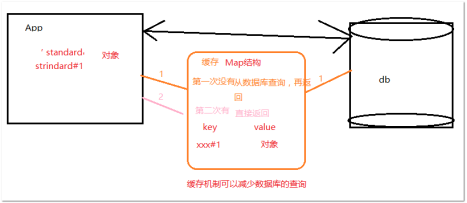1.ehcache:百度百科这样解释的,EhCache 是一个纯Java的进程内缓存框架,具有快速、精干等特点,是Hibernate中默认的CacheProvider。总的来说,他的出现就是减少对数据库的访问次数。从数据库查询出来的数据放到缓存中,以便下次调用,大大减少了 开销,性能也得到了提高。
特点:
l Java界最出名的缓存框架,主要用于单机缓存,速度很快。
l 进程级别的缓存,多个线程可共享一个缓存数据。
其实现方式如下图所示:

2.简单的解释一下ehcache的核心配置文件

1 <!-- 硬盘上缓存的临时目录 --> 2 <diskStore path="java.io.tmpdir"/> 3 <!-- 4 maxElementsInMemory:内存中最大存放的元素的个数 5 eternal:是否永生,默认是false 6 timeToIdleSeconds:发呆闲置的时间,超过该时间,被清除,单位秒 7 timeToLiveSeconds:存活的事件,超过该时间被清除 8 maxElementsOnDisk:如果内存满了,溢出到硬盘上的临时目录中的存放的元素的个数 9 diskExpiryThreadIntervalSeconds:轮询时间,巡视组 10 memoryStoreEvictionPolicy:内存对象的清理策略,如果满了,怎么办? 11 策略有三个:LRU、LFU、FIFO 12 LRU:最少使用被清理,次数 13 LFU:时间,闲置最长的时间 14 FIFO:管道策略,先进先出 15 --> 16 <defaultCache 17 maxElementsInMemory="10000" 18 eternal="false" 19 timeToIdleSeconds="120" 20 timeToLiveSeconds="120" 21 maxElementsOnDisk="10000000" 22 diskExpiryThreadIntervalSeconds="120" 23 memoryStoreEvictionPolicy="LRU"> 24 <persistence strategy="localTempSwap"/> 25 </defaultCache>
l 如果你的数据只是临时存放到缓存,减轻数据库压力,用默认值就很好
l 如果你的数据要在程序运行过程中一直被查询,则建议将设置为所有的元素被清除,一般用于数据字典。
3.ehcache中的缓存注解
@Cacheable和@CacheEvict来对缓存进行操作
@Cacheable:将方法的返回值放入到缓存中
@CacheEvict:负责清除缓存
4.下面与Spring整合的案列
需求:将菜单数据放入Ehcache中。
4.1.引入坐标
<!-- ehcache的缓存框架 -->
<dependency>
<groupId>net.sf.ehcache</groupId>
<artifactId>ehcache-core</artifactId>
<version>2.6.10</version>
</dependency>
<!-- spring整合第三方框架的 -->
<dependency>
<groupId>org.springframework</groupId>
<artifactId>spring-context-support</artifactId>
<version>${spring.version}</version>
</dependency>
4.2.编写配置文件(ehcache文件)
<!-- <ehcache xmlns:xsi="http://www.w3.org/2001/XMLSchema-instance" xsi:noNamespaceSchemaLocation="http://ehcache.org/ehcache.xsd">
--><ehcache xmlns:xsi="http://www.w3.org/2001/XMLSchema-instance" xsi:noNamespaceSchemaLocation="../config/ehcache.xsd">
<!-- 磁盘上的缓存的临时目录 ,默认是系统的临时目录,也可以手动指定一个目录-->
<diskStore path="java.io.tmpdir"/>
<!-- 默认的缓存区域的默认策略 -->
<!--
maxElementsInMemory:内存中元素最大存放的个数
eternal:缓存的对象是否永生不死。一般都是false。
timeToIdleSeconds:发呆的时间,多长时间不用,就干掉,秒
timeToLiveSeconds:存活的时间,活够了就干掉,秒
maxElementsOnDisk:硬盘上最大存放的元素的个数,如果内存10000个满了,就往硬盘上存。
memoryStoreEvictionPolicy:内存中存储和销毁元素的策略:默认使用LRU,解决的是缓存元素满了怎么办。
策略有三个:LRU、LFU、FIFO
LRU:最少使用被清理,次数
LFU:时间,闲置最长的时间
FIFO:管道策略,先进先出
-->
<defaultCache
maxElementsInMemory="10000"
eternal="false"
timeToIdleSeconds="120"
timeToLiveSeconds="120"
maxElementsOnDisk="10000000"
diskExpiryThreadIntervalSeconds="120"
memoryStoreEvictionPolicy="LRU">
<persistence strategy="localTempSwap"/>
</defaultCache>
<!-- Spring整合的菜单缓存 -->
<cache name="bos_menu_cache"
maxElementsInMemory="10000"
eternal="false"
timeToIdleSeconds="120"
timeToLiveSeconds="120"
maxElementsOnDisk="10000000"
diskExpiryThreadIntervalSeconds="120"
memoryStoreEvictionPolicy="LRU">
<persistence strategy="localTempSwap"/>
</cache>
4.3.Spring整合encache配置文件(需要引入ehcache文件)
<?xml version="1.0" encoding="UTF-8"?>
<beans xmlns="http://www.springframework.org/schema/beans"
xmlns:xsi="http://www.w3.org/2001/XMLSchema-instance"
xmlns:context="http://www.springframework.org/schema/context"
xmlns:cache="http://www.springframework.org/schema/cache"
xsi:schemaLocation="
http://www.springframework.org/schema/beans
http://www.springframework.org/schema/beans/spring-beans.xsd
http://www.springframework.org/schema/context
http://www.springframework.org/schema/context/spring-context.xsd
http://www.springframework.org/schema/cache
http://www.springframework.org/schema/cache/spring-cache.xsd">
<!-- 配置ehcache的对象EhCacheManager -->
<bean id="ehCacheManager" class="org.springframework.cache.ehcache.EhCacheManagerFactoryBean">
<!-- 注入ehcache核心配置文件的位置 可以不配置,默认找类路径下的ehcache.xml -->
<property name="configLocation" value="classpath:ehcache.xml" />
</bean>
<!-- Spring整合Ehache -->
<!-- Spring的平台缓存管理器 -->
<bean id="springCacheManager" class="org.springframework.cache.ehcache.EhCacheCacheManager">
<!-- 注入ehcache的对象 -->
<property name="cacheManager" ref="ehCacheManager"></property>
</bean>
<!-- spring的缓存注解驱动 -->
<cache:annotation-driven cache-manager ="springCacheManager" />
</beans>
4.4.在需要操作缓存数据的方法上添加注解
package cn.bos.service.impl.system;
import java.util.List;
import org.springframework.beans.factory.annotation.Autowired;
import org.springframework.cache.annotation.CacheEvict;
import org.springframework.cache.annotation.Cacheable;
import org.springframework.stereotype.Service;
import org.springframework.transaction.annotation.Transactional;
import cn.bos.dao.system.MenuRepository;
import cn.bos.domain.system.Menu;
import cn.bos.domain.system.User;
import cn.bos.service.system.MenuService;
@Service("menuService")
@Transactional
public class MenuServiceImpl implements MenuService{
@Autowired
private MenuRepository menuRepository;
@Override
public List<Menu> menu_list() {
return menuRepository.findAll();
}
@Override
//清除所有的缓存
@CacheEvict(value="bos_menu_cache",allEntries=true)
public void menu_add(Menu model) {
if(model.getParentMenu()!=null&&model.getParentMenu().getId()==null){
model.setParentMenu(null);
}
menuRepository.save(model);
}
@Override
//@Cacheable(value="bos_menu_cache")方法的结果放到缓存中
// 使用用户的标号作为缓存的key
@Cacheable(value="bos_menu_cache",key="#user.id")
public List<Menu> findMenuByUser(User user) {
// 管理员 所有菜单
if("admin".equalsIgnoreCase(user.getUsername())){
return menuRepository.findByOrderByPriority();
}else{
// 普通用户(显示部分菜单)
return menuRepository.findByUser(user);
}
}
}
注意:实体类中的序列化问题:
序列化的id,用来作为序列化和反序列化的唯一标识,默认的值是根据类的内容计算出来,如果类的内容发生变化,则值会变,例如:反序列化之前,将类改变内容了,那么反序列化将会失败。因此,为了保障反序列化成功,一般将该id的值定死!(随机数)
